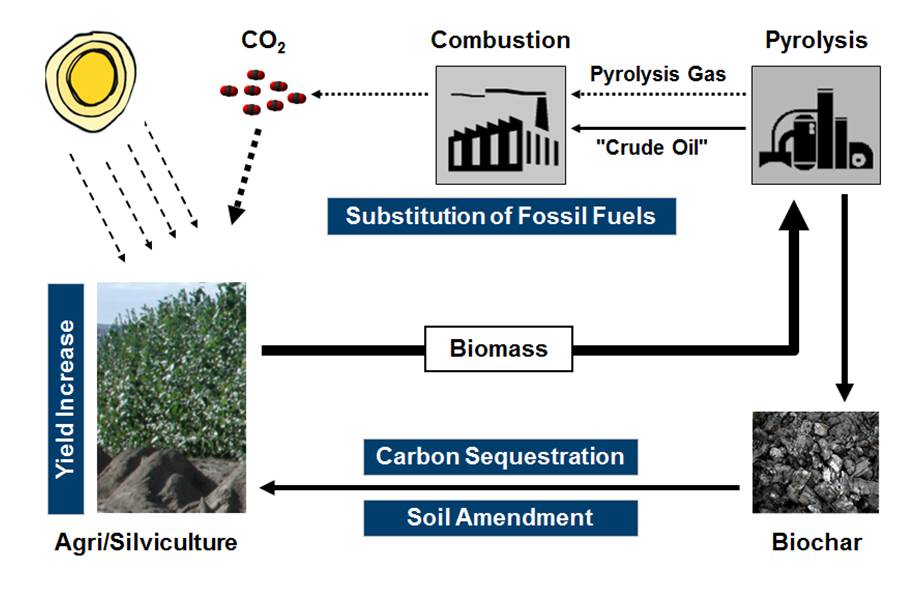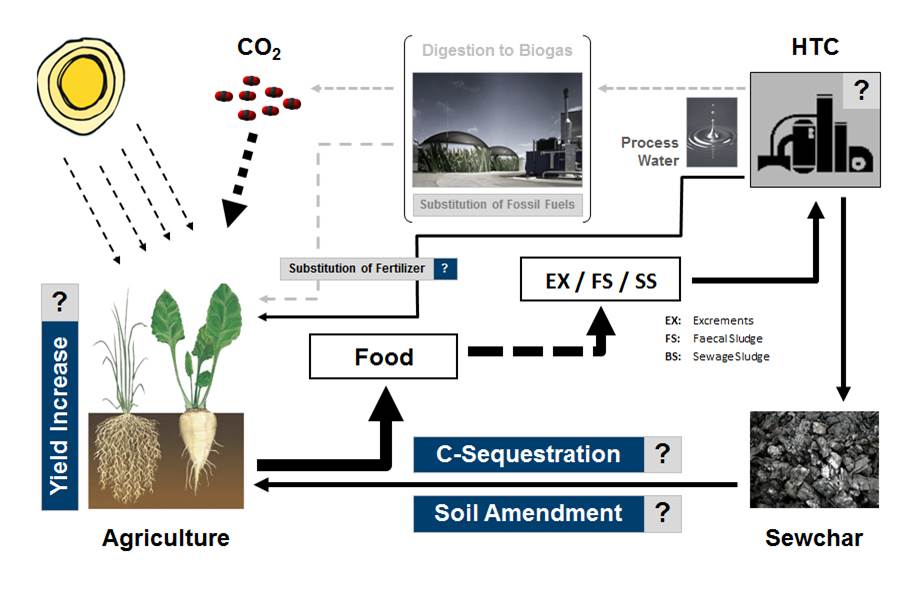Thermochemical Sludge Treatment and the Sewchar Concept
An Innovative Approach for Sustainable Sanitation
The mitigation of climate change, the protection of natural resources and the provisioning of sufficient food and healthy living conditions for a growing world population are most prominent challenges of our time
The so called sewchar concept addresses these interrelated challenges by combining the treatment of fecal and sewage sludges with the principles of the biochar concept: human waste and sewage sludges are treated either by pyrolysis or hydrothermal carbonization (HTC) and are then applied as carbon enriched and refractory soil amendments. The concept "sews" the principles and benefits of the biochar concept with the need for sustainable sanitation.
The sewchar concept is a feedstock specific derivative of the biochar concept
Biochar systems intend to mitigate climate warming via: i) long term soil sequestration of photosynthetically bound carbon; ii) reduced greenhouse gas emissions in the course of land management; and iii) the substitution of fossil fuels by energy-rich volatile co-products of the conversion process. Since biochars act as soil amendments their production and reuse can allow for a continuous and self-energizing carbon allocation from the atmosphere to the soil.

Sewchar systems can allow for climate change mitigation, soil amelioration, environmental and human health protection and sustainable resources management in a synergistic way
In contrast to directly plant-derived feedstocks used in biochar systems carbonaceous materials from the sanitation sector do not face any relevant competition from alternative utilization routes. In addition, human waste and sewage sludge usually undergo treatment and disposal at high environmental and economic costs. In many developing countries human excreta lack sufficient treatment and as a result may have negative impacts on human health and the environment. In industrialized countries concerns about the perceived risks associated with inorganic and organic contaminants has led to significant debate about the use of sewage sludge from conventional wastewater treatment systems as a soil amendment.
While facing the need for new sustainable concepts, thermochemical carbonization technologies offer the possibility to: (i) remove pathogens; (ii) degrade organic contaminants; (iii) eliminate or demobilize inorganic pollutants; and (iv) improve the overall energy and material resource efficiency of sanitation systems. Conceptually, the generation of sewchars from human waste and sewage sludge and their soil application provide, thus, social, economic and environmental benefits not only for climate change mitigation and soil amelioration but also for the protection of human health as well as material and energy resources.
Different conversion technologies can be employed in sewchar systems
In contrast to pyrolysis the reactions of hydrothermal carbonization (HTC) proceed in the presence of free water and enable thereby the thermochemical conversion of parent materials with inherently high moisture contents. In addition, HTC has the potential to provide advantages with respect to the efficiency of wastewater treatment processes and the recovery of plant mineral nutrients such as nitrogen and phosphorus. As a result, HTC seems to be particularly suited to sewchar systems. However, the technical development as well as the investigations into the characteristics and the effects of the products of HTC are in their infancies.

Research and Development Work
In order to develop economically viable and environmentally sound sewchar strategies for developing and industrialized countries we are integrating aspects of conversion technology and site conditions, but also governmental and (socio-) economical frameworks in our R & D work. Being the most fundamental elements for the sewchar concept the physicochemical characteristics of the products of pyrolysis and HTC as well as their effects on soil traits and the plant growth are in the focus of our scientific interests.
Cooperation, internal
Department of Community Ecology / Research Station Bad Lauchstädt - UFZ BZF
Cooperation, external
Deutsches Biomasse Forschungszentrum - DBFZ
Contact
Dr. Christoph Fühner
Phone +49 (0)341 235 1878
Fax +49 (0)341 235 1830
Dr. Marc Breulmann
Phone +49 (0)341 235 1015
Fax +49 (0)341 235 1830
